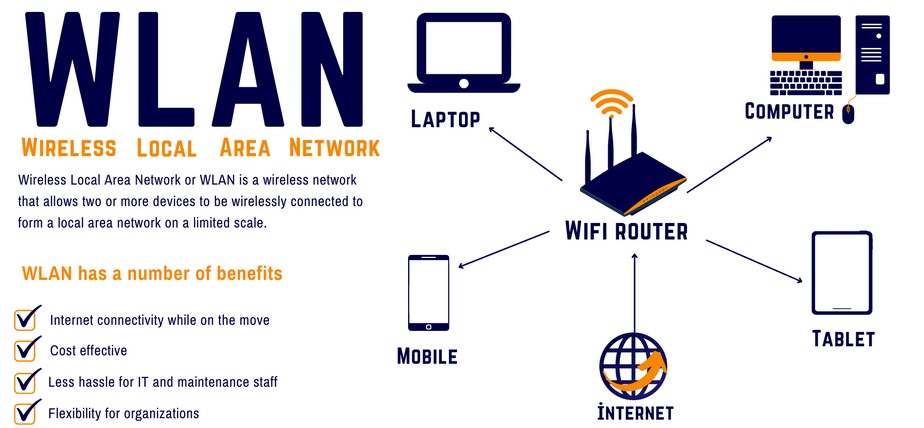

The full name of WLAN is Wireless Local Area Network, which refers to a wireless network communication technology designed to provide local wireless connections for devices in limited areas such as homes, offices or campuses. To understand the communication technology used in a WLAN, you need to consider the following:

Standardization: WLANs use standards specified by the Institute of Electrical and Electronics Engineers (IEEE) in their 802.11 series of standards, which define the technical specifications for wireless communications in local area networks. There are several variants of the IEEE 802.11 standard, such as 802.11a, 802.11b, 802.11g, 802.11n, and 802.11ac, each with different specifications for data rates, frequency bands, and security features.
Radio Frequency: WLANs use radio frequency (RF) signals to transmit data between devices. The frequency band used by a WLAN depends on the specific 802.11 standard used. For example, 802.11a uses the 5 GHz band, while 802.11b uses the 2.4 GHz band.
Data Rate: The data rate of a Wi-Fi refers to the speed at which data can be transferred between devices. The data rate of a WLAN depends on the specific 802.11 standard used and other factors such as the distance between devices and the amount of interference in the environment.
Security: WLANs use a range of security technologies to prevent unauthorized access, eavesdropping, and data tampering. Common security technologies used in WLANs include Wired Equivalent Privacy (WEP), Wi-Fi Protected Access (WPA), and Wi-Fi Protected Access II (WPA2).
In summary, the communication technology used in WLAN is based on the 802.11 family of standards and involves the use of radio frequency signals to transmit data between devices. The specifics of this wireless technology depend on the variant of the 802.11 standard used and the specific requirements of the WLAN.
lifi wireless communication technology
Introduction to common communication protocols of WLAN:
Wireless Local Area Networks (WLANs) use a variety of protocols to communicate between devices. The most commonly used protocol for WLANs is the IEEE 802.11 standard, which includes several wireless LAN specifications, including:
802.11a: This specification operates in the 5 GHz band and supports data rates up to 54 Mbps.
802.11b: This specification operates in the 2.4 GHz band and supports data rates up to 11 Mbps.
802.11g: This specification operates in the 2.4 GHz band and supports data rates up to 54 Mbps.
802.11n: This specification operates on the 2.4 GHz or 5 GHz band and supports data rates up to 600 Mbps.
802.11ac: This specification operates in the 5 GHz band and supports data rates up to 1 Gbps.
In addition to these protocols, other wireless communication protocols are used in WLAN, such as Bluetooth protocol, WiFi protocol, Zigbee protocol, lora technology and so on. These protocols can be used to support specific functions and applications, such as low power consumption, anti-interference, high-speed continuous transmission, relay networking and other communication functions.







